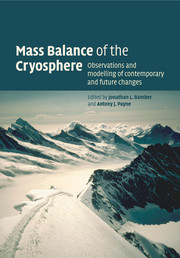Book contents
- Frontmatter
- Contents
- List of contributors
- Foreword
- Preface
- 1 Introduction and background
- Part I Observational techniques and methods
- 2 In situ measurement techniques: land ice
- 3 In situ measurement techniques: sea ice
- 4 Remote-sensing techniques
- Part II Modelling techniques and methods
- Part III The mass balance of sea ice
- Part IV The mass balance of the ice sheets
- Part V The mass balance of ice caps and glaciers
- Index
- References
3 - In situ measurement techniques: sea ice
Published online by Cambridge University Press: 16 October 2009
- Frontmatter
- Contents
- List of contributors
- Foreword
- Preface
- 1 Introduction and background
- Part I Observational techniques and methods
- 2 In situ measurement techniques: land ice
- 3 In situ measurement techniques: sea ice
- 4 Remote-sensing techniques
- Part II Modelling techniques and methods
- Part III The mass balance of sea ice
- Part IV The mass balance of the ice sheets
- Part V The mass balance of ice caps and glaciers
- Index
- References
Summary
Current techniques
We can learn a great deal about sea ice from satellite and aircraft surveys – its extent, its type, its surface features. But its thickness is hard to measure by remote sensing, because the brine cells in the ice give it a high electrical conductivity such that electromagnetic waves do not easily penetrate. The radio-echo sounding methods which have been used to measure the thickness of terrestrial ice sheets and glaciers cannot therefore be used for sea ice.
So far, five direct techniques have been commonly employed for measuring ice-thickness distribution. In decreasing order of total data quantity, they are:
submarine sonar profiling;
moored upward sonars;
airborne laser profilometry;
airborne electromagnetic techniques;
drilling.
Submarine sonar profiling
Most synoptic data to be published so far have been obtained by upward sonar profiling from submarines. Beginning with the 1958 voyage of Nautilus (Lyon, 1961; McLaren, 1988), which was the first submarine to the North Pole, many tens of thousands of kilometres of profile have been obtained in the Arctic by US and British submarines, and our present knowledge of Arctic ice-thickness distributions derives largely from the analysis and publication of data from these cruises. Problems include the necessity of removing the effect of beamwidth where a wide-beam sonar has been employed (Wadhams, 1981), and the fact that the data are sometimes obtained during military operations, which necessitates restrictions on the publication of exact track lines. For the same reason, the data set is not systematic in time or space.
- Type
- Chapter
- Information
- Mass Balance of the CryosphereObservations and Modelling of Contemporary and Future Changes, pp. 43 - 58Publisher: Cambridge University PressPrint publication year: 2004
References
- 1
- Cited by



